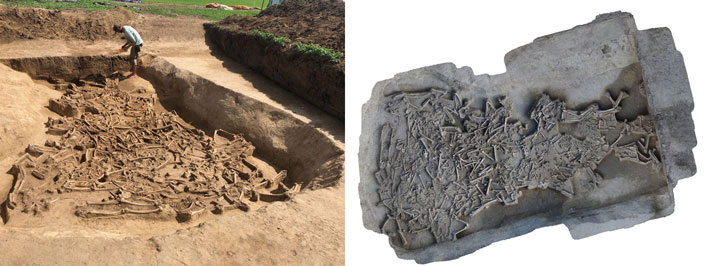Neolithic Mass Grave Mystery
May/June 2023
 A team of archaeologists from Kiel University and the Institute of Archaeology of the Slovak Academy of Sciences unearthed an unusual mass grave at the Neolithic site of Vráble in Slovakia. Vráble was inhabited from about 5250 to 4950 B.C. by people belonging to what scholars call the Linear Pottery culture. At its peak, the site consisted of three neighboring settlements of around 80 houses in all, making it especially large for the time. The team discovered 37 skeletons missing their skulls in a ditch surrounding one of the villages. Mass graves have been found in ditches at other Linear Pottery sites, but none excavated thus far have contained decapitated bodies. Evidence of large-scale massacres at other mass graves suggests the Linear Pottery people entered a period of crisis around 5100 B.C. The headless burials at Vráble may have been part of a response to this upheaval. “The ritual depositions could be some kind of social coping mechanism of a magical or religious nature that people performed to get back control in a time when things seemed to be falling apart,” says archaeologist Martin Furholt. Excavation and dating of other settlements in the area show that they were being abandoned around the time the headless bodies were buried. Meanwhile, the population at Vráble was growing, perhaps a result of newcomers seeking security in an increasingly unstable world.
A team of archaeologists from Kiel University and the Institute of Archaeology of the Slovak Academy of Sciences unearthed an unusual mass grave at the Neolithic site of Vráble in Slovakia. Vráble was inhabited from about 5250 to 4950 B.C. by people belonging to what scholars call the Linear Pottery culture. At its peak, the site consisted of three neighboring settlements of around 80 houses in all, making it especially large for the time. The team discovered 37 skeletons missing their skulls in a ditch surrounding one of the villages. Mass graves have been found in ditches at other Linear Pottery sites, but none excavated thus far have contained decapitated bodies. Evidence of large-scale massacres at other mass graves suggests the Linear Pottery people entered a period of crisis around 5100 B.C. The headless burials at Vráble may have been part of a response to this upheaval. “The ritual depositions could be some kind of social coping mechanism of a magical or religious nature that people performed to get back control in a time when things seemed to be falling apart,” says archaeologist Martin Furholt. Excavation and dating of other settlements in the area show that they were being abandoned around the time the headless bodies were buried. Meanwhile, the population at Vráble was growing, perhaps a result of newcomers seeking security in an increasingly unstable world.